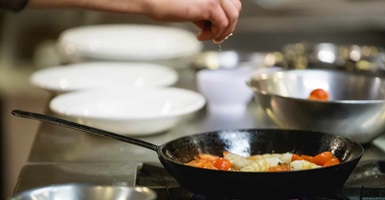Some folk seem to be gifted with an ultra-green thumb. Others, well, they look at a plant and it wilts. If you’re in the latter category, it’s worth persevering. “Plants – and the microbes that live in the potting soil with them – actually clean the air,” says Frances Saunders, Chisholm’s horticulture expert. “Many nasty gases are given off by plastics, computers and other office materials, but the plant roots and those microbes literally ‘gobble’ these up.” Luckily, Frances has five suggestions for indoor plants that are so hardy not even the worst of gardeners can kill them off.
- Peace lily (Spathiphyllum ‘Mauna Loa’)
Ideal for areas of the home with low light, the glossy leaves of the peace lily make it a favourite among house plants. Keep out of direct sunlight, water less in the cooler months and spray leaves with water regularly. - Heartleaf philodendron (Philodendron cordatum)
This philodendron is virtually indestructible. Ideal as a hanging or trailing plant, it likes medium indirect light and humidity. You can tell when it needs watering as the leaves will wilt a little, but allow the soil to dry out before you water. - Elephant-ear philodendron (Philodendron domesticum)
So named because its large leaves resemble elephant’s ears, this philodendron should go in a well-lit position away from direct sunlight. Allow the soil to dry out before watering, particularly during winter. Regularly remove dead stems from the base. - Red-edged dracaena (Dracaena marginata)
A tropical evergreen that is particularly hardy and the pinky-red edges of the strap-like leaves add a nice pop of colour. Its thickish trunk can store water so it only needs to be watered once or twice every two weeks. Prefers a spot with higher light than many other indoor plants. - Weeping fig (Ficus benjamina)
A lush tropical plant that prefers a warm, well-lit position away from direct sun. Keep the soil moist and try not to move the plant around: it doesn’t cope with being relocated. Clean the leaves regularly with a feather duster.
Tip-top house plants tips
Once you’ve chosen a hardy house plant, here’s Frances’ tips to keep them alive:
Don’t overwater
“The best method to test whether your indoor plants need water is the finger test. Stick your forefinger into the potting mix – not just the top 1cm. If your finger feels damp, your plant doesn’t need water.”
Put your plants outside in the rain now and then
“This will wash their leaves of dust and provide them with some delicious rainwater. If that’s hard for you to do, wipe the leaves over with a damp cloth to remove dust and dirt. And they love a water spray mist occasionally.”
Go gently with fertiliser
“Indoor plants generally grow slower than outdoor plants and excess fertiliser can build up in the soil, making it ‘salty’. So lightly fertilise in spring and autumn – about half strength, but read the instructions – depending on the species.
Repot regularly
“Keeping plants in the same potting media for years and years is a no-no. Plants need to be repotted every year into fresh potting soil.”
Be vigilant for pests
“Pests and diseases shouldn’t be a problem if you are vigilant, so check your plants regularly. Overwatering can cause fungal diseases and all manner of insects can be a problem if you let them get out of control.”
Be aware that some plants may be toxic to pets
If you have a pet, it’s a good idea to research which house plants are poisonous to animals before you head to your local nursery.


